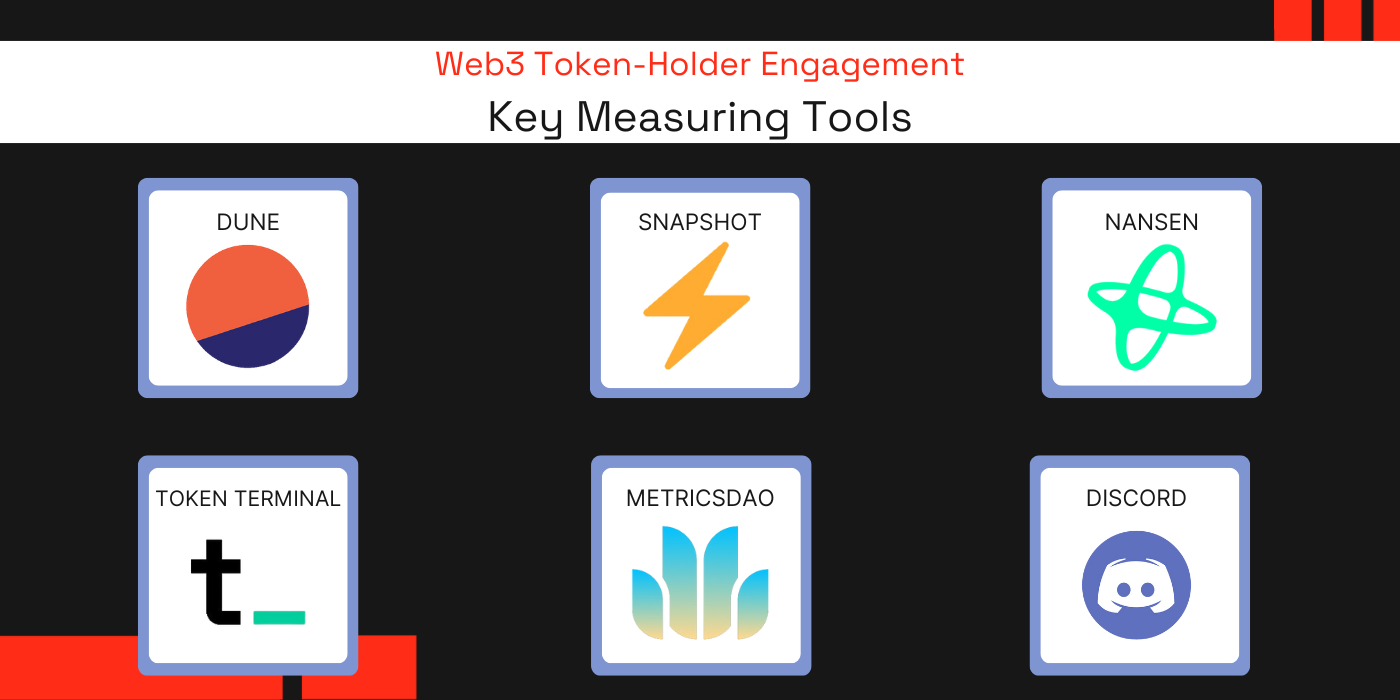Get insights.
Unlock value.
- Free plan, no time limit
- Set up in minutes
- No credit card required
Measuring Token-Holder Engagement: Metrics And Tools
Token-holder plays a critical role in Web3 community engagement. The success of a Web3 project heavily depends on token-holder engagement.
Someone once said, “Measuring is the first step to improvement”. There are metrics & tools that help community managers measure token-holder engagement. In this blog, I will discuss those metrics & tools.
Don’t miss this read. Let’s start.
Token-Holder Engagement: Key Metrics
I have identified 6 key metrics that measure Token-holder Engagement. They are listed below.
-
Active Participation Rate
Active participation rate measures the percentage of participating Token-holders. The active participation rate in community & project-related activities can be measured. This metric is a direct indicator of the token-holder’s community involvement.
Active Participation Rate = (Active participants / Total token-holders) * 100
-
Voting Turnout Rate
How many token-holders turn out to vote? The voting turnout rate is the percentage of token-holders who vote on governance decisions. This metric reflects the token-holder’s interest in the governance & decision-making process. The voting frequency is also a defining metric.
Voting Turnout Rate = (Voted token-holders / Total eligible token-holders ) * 100
-
Proposal Engagement Rate
The proposal engagement rate measures the number of proposals discussed, reviewed & acted upon. This metric reflects the power of community response to governance proposals.
Proposal Engagement Rate = ( Token-holders engaged with proposal / Total token-holders ) * 100
-
Staking Participation Rate
Verifying & validating the transactions on BlockChain is called Staking. The staking rate measures token-holders who own tokens by validating BlockChain transactions. It also helps differentiate Staking & Non-Staking holders. The staking rate reflects the commitment to long-term belief.
Staking Participation Rate = ( Token-holder staking tokens / Total token-holders ) * 100
-
Social Media Engagement Rate
Token-holder activity in social media like Twitter & Discord can be measured. Views, likes, comments & followers on a social media post are a direct indicator of engagement. Sentiment analysis can be done to capture community mood.
Social Media Engagement Rate = ( Total engagement / Total impressions ) * 100
-
On-Chain Engagement Rate
On-chain engagement measures the token-holder transaction volume & frequency on the BlockChain. This metric also measures unique Token-holder interactions on the BlockChain. Finally, it helps measure overall activity on-chain in real-world scenarios.
On-Chain Engagement Rate = ( Active on-chain participants / Total Token-holder ) * 100
Token-Holder Engagement: Key Measuring Tools
This section describes the key tools involved in measuring Token Holder engagement.

-
Dune
Dune is a data analytics platform for measuring token-holder engagement on Chain. Dune directly queries BlockChain and provides you with engagement insights. It tracks on-chain metrics like active addresses, successful transactions & voter turnouts.
Key reveals: Active addresses, Voter turnouts
-
Snapshot
Snapshot is a decentralized voting system for DAOs. It helps measure token-holder engagement in governance proposals. Snapshot also measures participation rate while voting on important decisions.
Key reveals: Governance engagement, Participation rate
-
Nansen
Nansen is another BlockChain Analytics platform just like Dune. Nansen helps measure Crypto wallet behaviors. This analytics platform also helps track token & whale movements. In case you are not aware, a crypto whale is a user who holds a significant amount of Cryptocurrency.
Key reveals: Wallet behaviors, token & whale movements
-
Token Terminal
Token Terminal is an analytics platform focusing on evaluating financial metrics & providing financial insights into Crypto assets. This platform helps evaluate crypto project revenue.
Key reveals: Financial insights, Project Revenue
-
MetricsDAO
Metrics DAO is a community-driven analytics platform for Web3. This platform provides crowdsourced insights for measuring token-holder engagement. It not only helps measure metrics but also identifies the latest trends among token-holders.
Key reveals: Crowdsourced insights, latest trends
-
Discord / Telegram Bots
Discord & Telegram bots help track Token-holder activity. These bots help track sentiments within the token-holder community. These bots trigger alerts when a spike in community activity is detected.
Key reveals: Sentiments, Sudden spikes
You can find here the best practices for building Strong Token-holder relationships.
How can BlockSurvey help?
Here let’s find how a data collection tool like BlockSurvey can help measure token-holder engagement. Below are a few methods to measure token-holder engagement while running a survey.
- Survey Response & Completion Rates are clear measures of Token-holder engagement.
- Survey response data are analysed using AI to capture token-holder sentiment.
- Token-Gating feature helps you measure how many Token-holders participated in your survey.
Conclusion
Why not start monitoring your token-holder engagement using the discussed tools. Be open & refine your process to improve token-holder engagement. Here is what Stanley Thomas, an NFT analyst has to say on how to measure Web3 community management success.
Start creating engagement Surveys using BlockSurvey. Measure survey response & completion rates. Find token-holder sentiments with AI data analytics. Measure the Token-holder’s survey participation with the help of the Token-Gating feature. There is a lot more to it. Start experiencing BlockSurvey today & improve token-holder engagement.
Measuring Token-Holder Engagement: Metrics And Tools FAQ
What are the key challenges in measuring Token-holder engagement?
Measuring Token-holder engagement can be challenging due to several factors. Data accuracy can be an issue. Varying levels of participation among Token-holders can skew metrics. It's important for community managers to regularly validate the data.
How Token-holder engagement metrics be used to make strategic decisions?
For example, low active participation or voting turnout rates might indicate a need for more engaging communication. High staking rates could suggest a strong belief in the project’s long-term success, prompting initiatives that further leverage this commitment. By analyzing social media sentiment and on-chain activity, community managers can identify potential issues early and address them proactively.
Are there any privacy concerns related to using these tools?
Privacy concerns are a critical consideration when using analytics tools to measure Token-holder engagement. Many of these tools, like Dune and Nansen, analyze on-chain data, which, although publicly available, can still raise concerns about individual Token-holder anonymity. Additionally, platforms like Discord or Telegram may collect data from private chats, potentially infringing on users’ expectations of privacy.
What are some best practices for increasing Token-holder engagement?
Encouraging active participation can be achieved by fostering open communication channels, such as AMAs or regular updates. Recognizing and rewarding active participants can also motivate others. Additionally, addressing any negative sentiments detected through social media analysis quickly and transparently helps maintain trust and engagement within the community.
Get insights.
Unlock value.
- Free plan, no time limit
- Set up in minutes
- No credit card required


